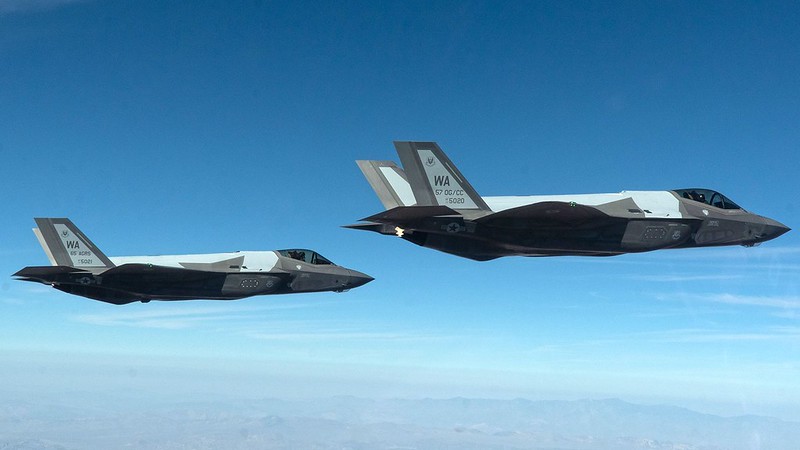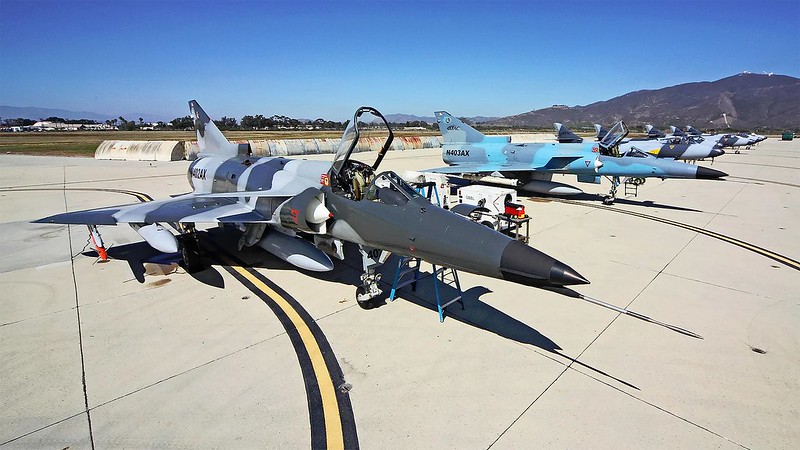I posted a photo of U.S. Air Force aggressor aircraft to Facebook. Friends were intrigued. I answered some of their questions in comments, but it’s a subject worth exploring in more detail, and my blog is the best place for that.
F-15 & F-16 aggressors (photo: Jamie Hunter)
The photo showed a mix of USAF fighters wearing striking camouflage paint schemes: two F-15 Eagles and two F-16 Vipers. These jets, and their pilots, belonged to units once based at Nellis AFB, Nevada, the 64th and 65th Aggressor Squadrons. The pilots who flew them were regular fighter jocks trained in enemy tactics, whose mission was to provide realistic air-to-air combat training to Air Force and allied aircrews participating in Red Flag exercises.
Aggressor training goes back to a program conducted in secrecy during WWII. The Germans had a few captured Allied fighters, and after training some of their own pilots to fly them, allowed a few top Luftwaffe aces to dogfight them so that they could see and understand the capabilities and limitations of Mustangs and Spitfires, then share their knowledge with other Luftwaffe pilots. I don’t doubt we did the same thing. The number of pilots who ever got to participate in programs like that was very small, a problem that persisted into the 1980s, when I myself got to dogfight a MiG-21 and a MiG-23 in what at the time was a highly classified program (you can read about it here).
Ideally, the best aircraft for air combat training are actual enemy aircraft, but they’re hard to get and programs using them are necessarily small and secret. If you don’t have an aggressor unit handy, the next best choice for air combat training is to fight dissimilar aircraft. In my day, that usually meant going up in our F-15s to fight Navy or Marine pilots in F/A-18s, or against USAF pilots flying other types of fighters: F-16s, F-4s, A-7s, and so on. Worst of all was to fight other F-15s flown by squadron mates: in a turning fight, unless you have godlike situational awareness, it’s difficult to tell friend from foe when everyone’s flying identical gray jets. That, though, was the normality: 80% of the air combat training I ever flew was against pilots and aircraft from my own units. The much smaller number of missions I flew against trained aggressor pilots, or even regular fighter pilots in other types of aircraft, were the missions where I learned the most.
The Navy and Air Force embraced the idea of dedicated aggressor squadrons in the 1970s. If you’ve seen the original Top Gun movie, you remember Maverick and Goose going up in their F-14 Tomcat to fight Top Gun instructors flying old A-4 Skyhawks … the Navy’s choice of an American aircraft with performance similar to the MiG-17, still in use by several potential adversary nations. The USAF elected to use F-5E Tigers, a lightweight fighter developed for export. The F-5E was about the same size and capability of the MiG-21, very much a threat in those days.
F-5E aggressors (photo: Paul Bradley)
These are F-5E Tiger II fighters, used as aggressors by the USAF from the mid-1970s through the late 1980s (and still in use by the Navy and Marines). Note the Russian-style camouflage patterns with red stars on the tail and numbers on the nose. All of my air combat with USAF aggressors was against F-5s like these. The Nellis-based F-15 and F-16 aggressors (top photo) came after I retired, and were used from 2005 to 2014. You notice there’s a big gap there … I don’t know about the Navy and Marine Corps, but the USAF runs hot and cold on aggressor training, and the program periodically goes into hibernation.
When I flew against F-5 aggressors, I faced a highly maneuverable, fast little jet that was damn hard to see and keep track of in a visual turning fight. And there were always a swarm of them, just as there would have been swarms of MiG-21s and -23s during the first days of any actual war. The F-5s weren’t our equal in terms of long-range radars and missiles, but then again at the time there were very few MiGs or Sukhois that could match the F-15. The F-5 was a good representation of the threat we were most likely to face in combat.
Which brings me to generations. Jet fighters have ’em. The F-15s I flew are 4th generation fighters. The F-5s, and the MiGs they simulated, were somewhere between 2nd and 3rd generation fighters. Today, the US, Russia, China (and several European nations) have 5th generation fighters, and at least at Nellis AFB, which has reactivated an aggressor squadron (yay!), pilots of 5th generation fighters like the F-22 Raptor and F-35 Lightning II now get to train against 5th generation aggressors, because we’re now using F-35s in that role (note: there’s one other USAF aggressor squadron, still flying 4th-generation F-16s at Eielson AFB in Alaska).
F-35 aggressors (photo: TSgt Alexandre Montes)
Current USAF aggressor aircraft, whether 5th-generation F-35s or 4th-generation F-16s, continue to be painted in distinctive camouflage patterns, easier for the F-35 and F-16 pilots fighting them to pick out in a visual fight.
Airborne Tactical Advantage Company Kfir & Hawker Hunter aggressors (photo: Tyler Rogoway)
I should briefly mention civilian contractor aggressors. The USAF contracts with private companies to provide adversary training at bases around the US and overseas. These companies hire experienced, recently-qualified military pilots to fly a variety of 2nd- and 3rd-generation foreign fighters like the Israeli Kfir and Hawker Hunter, aircraft USAF pilots rarely get to fight against, let alone see.
Talk about a dream retirement job for a former F-15 jock!




Interesting. A friend and former squadron mate writes:
“Just read your blog on aggressors. Great summary. Just FYI confirming something you put in, my Dad’s logbook during WW2 has a 25 minute entry flying a captured Ju 88!”
Good post. I’m surprised there are not more collisions in those training furballs, seems like one sneeze and you bought the farm.
The Soviets and now the Russkies had some striking camouflage patterns though sometimes I can’t see where they would blend with any sky, cloud or landscape. That ‘blocks of angular different grays’ air superiority paint job blends with everything.
I had a hard time with ‘bort’ number translation, the big numerals on nose and tail, often red in color- nothing to do with borscht as you might think:
“English words for ???? include board, bead, side, broadside, bort, flange, cushion, ledge, skirting and ramp.” ‘Side’ or ‘broadside’ must be it. They’ve listed ‘bort’ as the English translation of Russian ‘bort’, that is not a word in English… Oops, my bad, made me look:
Wikipedia: ‘Bort. Bort, boart, or boort is an umbrella term used in the diamond industry to refer to shards of non- gem -grade/quality diamonds. In the manufacturing and heavy industries, “bort” is used to describe dark, imperfectly formed or crystallized diamonds of varying levels of opacity…”.
Tod recently posted…Cheapskate Tips: Best Cheap Battery Mower for Small Lawns
Tod says “I’m surprised there are not more collisions in those training furballs, seems like one sneeze and you bought the farm.”
It does happen, thankfully not all that often. In my 24-year hitch, I recall around a dozen. One would think big furballs, as you mention, where four or more fast fighters occupy the same small area, all turning hard and trying to get in kill positions on one another (or avoid same) would be the most dangerous, but in my experience one-on-one is where most midairs happen, often at relatively low speed during scissors maneuvers, when both fighters run out of energy and are unable to turn away from an impending collision. Can’t think of any that have happened at huge exercises like Red Flag, where 100 or more fighters, attack jets, and bombers go at one another on the Nellis ranges north of Las Vegas.